The sun was beaming overhead when I first stepped into the Trinity Botanic Gardens. I met the other intern, Eva, as well as Michelle, Steve, the gardeners, Liz and Mick, and Fluffy the cat (who took a moment to get used to us!).
We took a tour of the grounds, from the grand arboretum to the glass houses and walled garden, and through Trinity Hall grounds next door. We were really able to get a feel of our place in the gardens and the sheer responsibility it takes to tend to them.
We started off lightly on the first week, with only four days to begin with due to the bank holiday. Because one of the gardeners was away, we were given the task of monitoring irrigation in the glass houses.
I was in charge of the cycad house – this is an arid house containing a large collection of cycads and collections from the Canary Islands. I really enjoyed seeing such a wide array of different plants, some tiny, some big, some with many flowers and some with very little — but my favourite was definitely the Phoenix canariensis, the Canary Islands date palm. Despite already being in a massive pot, it had broken through the bottom and sides, and grown above the top with its roots! When planted in the ground, these roots spread deep and wide. This allows the Canary Islands date palm to be very drought resistant while still nurturing its large fronds and thick trunk.


We then planted some Cosmos binpinnata ‘Xanthos’ in front of the glass houses – these had been sown by 3rd year Botany students in April – making sure to give them a good watering after disturbing their roots.
Cosmos are members of one of the largest plant families, the Asteraceae, and have antenna-shaped petals and thin, branching leaves. These leaves are an adaptation that allows the cosmos to thrive in windy conditions — the small surface area prevents the wind from catching on the leaf and uprooting the plant. The antenna-shaped head of petals is also an adaptation — when the wind blows against the flower, the flower turns away from it to protect the disc of fertile flowers in the centre of the flower head – amazing!
We also attempted to pot up a young Echium pininana (part of the Boraginaceae family) that had seeded itself. It has taken a while to settle, and we thought it wouldn’t survive the shock, but after a week it now looks as if it will pull through after all – success!
The fully grown Echium pininana is often called tower of jewels, and for good reason — the plant can grow up to 5 meters tall, and has hundreds of tiny purple flowers that bloom from February to June.
We finished off our first week by making a start on repotting and topping up the soil of plants set aside for the plant sale. My favourite plant from this area was the Philadelphus, which was in full bloom and extremely fragrant. Its scent attracts all types of pollinators, from bees and wasps, to butterflies and moths!



